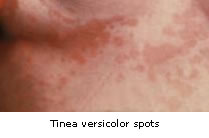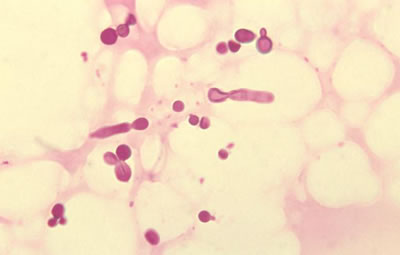Tinea versicolor
Tinea versicolor or pityriasis versicolor
is a common, mild yeast infection of the skin, which causes oval
and scaly spots. These spots are usually pale or pinkish in color.
Symptoms of Tinea Versicolor
The symptoms of tinea versicolor are:
- Oval spots with diameter of 1/4-in to 1 in.
- Scaly
- Multiple spots that can merge and cover a large area of the
skin
- Pale pink or tan in color that is more noticeable after suntanning
or on people with darker skin
- Itching that gets worse with sweating

These spots occur on areas of the skin that have large amounts
of sebaceous or oil glands, such as:
- Upper chest
- Back
- Neck
- Upper arm
- Face (occassionally)
The spots may disappear during the cold winter season and reappear
when the weather becomes warm and humid.
Cause of Tinea Versicolor
This mild infection is caused by a slow-growing yeast called
Malassezia furfur or Pityrosporum orbiculare.
This yeast normally grows on the skin without causing any problem.
However, in warm and humid environment, it grows in abundance
to cause an infection.

Tinea versicolor causing Malassezia
furfur yeast.
Who Gets It?
Most people with tinea versicolor are adolescents and young adults.
This condition is more prevalent in warm and humid climates.
In the United States, it is estimated that 2 to 8% of the population
has tinea versicolor.
Tinea Versicolor Treatment
Treatments for tinea versicolor include:
- Applying over-the-counter shampoo containing 1% selenium sulfide
on the affected areas for 10 to 15 minutes before rinsing. This
should be done daily for 2 weeks, and once a week afterwards.
- Prescription topical antifungal lotion containing 2.5% selenium
sulfide and 2% ketoconazole, with similar applications as above.
- Oral antifungal medications, taken for about 1 week.


